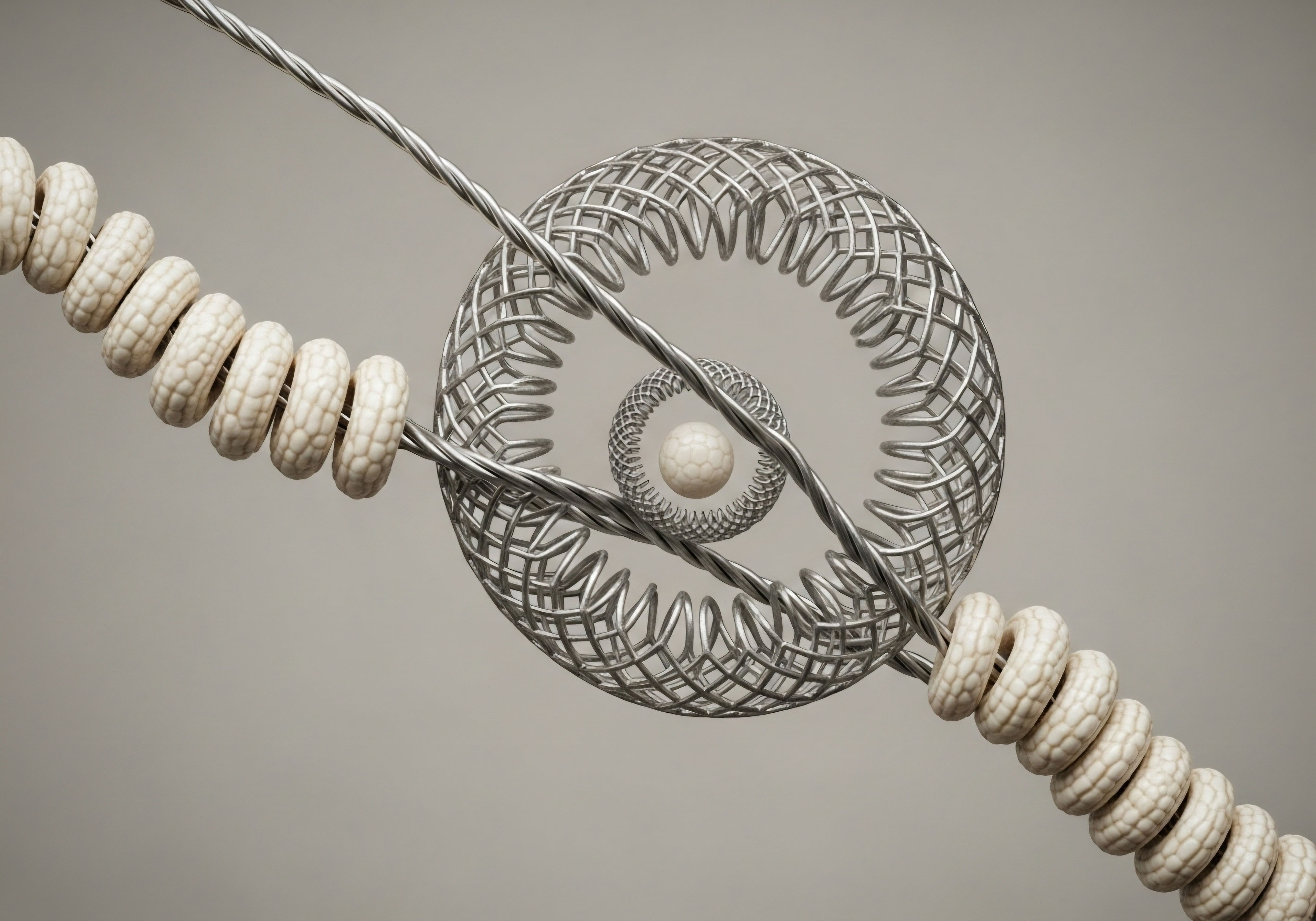

Fundamentals
The decision to begin a journey of hormonal optimization Meaning ∞ Hormonal Optimization is a clinical strategy for achieving physiological balance and optimal function within an individual’s endocrine system, extending beyond mere reference range normalcy. is a deeply personal one, often born from a desire to reclaim a sense of vitality and function that feels diminished. You may feel a persistent fatigue, a mental fog, or a decline in physical performance that impacts your quality of life. When you seek solutions like Testosterone Replacement Therapy Individuals on prescribed testosterone replacement therapy can often donate blood, especially red blood cells, if they meet health criteria and manage potential erythrocytosis. (TRT), you are taking a proactive step toward restoring your body’s equilibrium.
Within this context, the question of fertility presents itself as a primary and valid concern for many men. Understanding how to support your body’s systems, particularly the intricate network governing both vitality and reproductive capacity, is the first step toward making informed decisions that align with all of your life goals.

The Body’s Endocrine Command Structure
Your endocrine system operates through a sophisticated communication network known as the Hypothalamic-Pituitary-Gonadal (HPG) axis. Think of this as a precise and responsive chain of command. The hypothalamus, located in the brain, acts as the chief executive, sending out orders in the form of Gonadotropin-Releasing Hormone (GnRH). This signal travels to the pituitary gland, the senior manager, which in turn releases two key hormones ∞ Luteinizing Hormone Meaning ∞ Luteinizing Hormone, or LH, is a glycoprotein hormone synthesized and released by the anterior pituitary gland. (LH) and Follicle-Stimulating Hormone Meaning ∞ Follicle-Stimulating Hormone, or FSH, is a vital gonadotropic hormone produced and secreted by the anterior pituitary gland. (FSH).
These hormones are the direct messengers sent to the testes. LH specifically instructs a group of testicular cells, the Leydig cells, to produce testosterone. This locally produced testosterone, known as intratesticular testosterone, is essential for driving the process of sperm production, or spermatogenesis.
The system is elegantly self-regulating. When testosterone levels in the bloodstream are sufficient, they send a feedback signal back to both the hypothalamus and the pituitary, telling them to slow down the release of GnRH and LH. This negative feedback loop Meaning ∞ A negative feedback loop represents a core physiological regulatory mechanism where the output of a system works to diminish or halt the initial stimulus, thereby maintaining stability and balance within biological processes. ensures that testosterone production Meaning ∞ Testosterone production refers to the biological synthesis of the primary male sex hormone, testosterone, predominantly in the Leydig cells of the testes in males and, to a lesser extent, in the ovaries and adrenal glands in females. remains within a healthy, stable range.
Maintaining fertility during hormonal therapy involves directly stimulating the testes to preserve their natural sperm production capabilities.

How Hormonal Optimization Impacts Fertility
When you begin a protocol of Testosterone Replacement Meaning ∞ Testosterone Replacement refers to a clinical intervention involving the controlled administration of exogenous testosterone to individuals with clinically diagnosed testosterone deficiency, aiming to restore physiological concentrations and alleviate associated symptoms. Therapy, you are introducing testosterone from an external source. Your body’s HPG axis detects these elevated levels of testosterone in the bloodstream. Perceiving an abundance, the hypothalamus and pituitary halt their signaling. The release of GnRH, LH, and FSH slows dramatically or ceases altogether.
This shutdown of the body’s internal command structure has a direct consequence ∞ the Leydig cells in the testes no longer receive the LH signal to produce testosterone. While your blood serum testosterone levels Meaning ∞ Testosterone levels denote the quantifiable concentration of the primary male sex hormone, testosterone, within an individual’s bloodstream. are optimized by the therapy, the concentration of testosterone inside the testes plummets. Because this intratesticular testosterone Meaning ∞ Intratesticular testosterone refers to the androgen hormone testosterone that is synthesized and maintained at exceptionally high concentrations within the seminiferous tubules and interstitial spaces of the testes, crucial for local testicular function. is the primary fuel for spermatogenesis, its absence leads to a sharp decline in sperm production and can result in testicular atrophy or shrinkage.

Human Chorionic Gonadotropin a Molecular Bypass
This is where Human Chorionic Gonadotropin Growth hormone modulators stimulate the body’s own GH production, often preserving natural pulsatility, while rhGH directly replaces the hormone. (HCG) serves a critical function. HCG is a hormone that is structurally very similar to LH. Its molecular shape allows it to bind to and activate the very same receptors on the Leydig cells that LH would normally target. By administering HCG alongside TRT, you are creating a molecular workaround.
Even though the brain’s natural LH signal is suppressed, HCG acts as its direct replacement, delivering the “produce testosterone” message straight to the testes. This action maintains high levels of intratesticular testosterone, thereby preserving the environment necessary for continuous sperm production Meaning ∞ Sperm production, clinically known as spermatogenesis, is the biological process within the male testes where immature germ cells develop into mature spermatozoa. and preventing the testicular shrinkage associated with TRT alone. It allows for the systemic benefits of optimized testosterone levels while safeguarding the localized function required for fertility.


Intermediate
Advancing from the foundational principles of the HPG axis, we can now examine the specific clinical strategies used to integrate Human Chorionic Gonadotropin (HCG) into a hormonal optimization protocol. This involves understanding dosages, timing, and the synergistic use of other therapeutic agents to create a comprehensive system of support. The objective is a state of biochemical balance where systemic testosterone levels are optimized for well-being, and testicular function is preserved for fertility.

What Does a Typical Protocol Look Like?
A hormonal optimization plan that includes fertility preservation is designed to replicate the body’s natural signaling processes, even while the primary HPG axis Meaning ∞ The HPG Axis, or Hypothalamic-Pituitary-Gonadal Axis, is a fundamental neuroendocrine pathway regulating human reproductive and sexual functions. is suppressed by exogenous testosterone. The core principle is to provide both systemic testosterone and a direct testicular stimulus. This is accomplished by co-administering Testosterone Cypionate Meaning ∞ Testosterone Cypionate is a synthetic ester of the androgenic hormone testosterone, designed for intramuscular administration, providing a prolonged release profile within the physiological system. (or another ester) with low-dose HCG. The testosterone provides the stable, elevated serum levels needed to resolve symptoms of hypogonadism, while the HCG maintains the intratesticular machinery.
Protocols are personalized, yet a common clinical approach involves subcutaneous injections of HCG two to three times per week. A typical dosage ranges from 250 to 500 IU per injection. This frequency is determined by the half-life of HCG, which is approximately 36 hours, far longer than the 30-minute half-life of natural LH.
This extended duration of action allows for less frequent administration while providing a steady stimulus to the Leydig cells. The injections are typically timed to be on different days than the testosterone injection to maintain stable hormone levels throughout the week.
Effective HCG protocols are tailored to the individual, balancing the dose to maintain testicular volume and function without unwanted side effects.
The following table illustrates the differential impact of a TRT-only protocol versus a combined TRT and HCG protocol Meaning ∞ The HCG Protocol denotes a specific regimen that involves the administration of Human Chorionic Gonadotropin, a hormone, in conjunction with a very low-calorie diet, primarily advocated for weight reduction. on key biological markers.
| Parameter | TRT Only Protocol | TRT with HCG Protocol |
|---|---|---|
| Serum Testosterone |
Optimized (High-Normal) |
Optimized (High-Normal) |
| Intratesticular Testosterone (ITT) |
Severely Reduced |
Maintained at Normal Levels |
| Luteinizing Hormone (LH) |
Suppressed (Near Zero) |
Suppressed (Near Zero) |
| Follicle-Stimulating Hormone (FSH) |
Suppressed (Near Zero) |
Suppressed (Near Zero) |
| Sperm Production |
Significantly Impaired or Ceased |
Preserved in Most Cases |
| Testicular Volume |
Reduced (Atrophy) |
Maintained |

Ancillary Medications for Systemic Balance
The introduction of HCG can influence other hormonal pathways, sometimes necessitating the inclusion of additional medications to maintain overall endocrine equilibrium. The stimulation of testosterone production within the testes can also lead to an increase in its conversion to estradiol via the aromatase enzyme.
- Anastrozole An aromatase inhibitor (AI) like Anastrozole may be prescribed in low doses. It works by blocking the aromatase enzyme, thereby controlling the conversion of testosterone to estrogen. This helps prevent potential side effects associated with elevated estradiol, such as water retention or gynecomastia, ensuring the hormonal profile remains balanced.
- Injectable FSH While HCG effectively mimics LH to stimulate testosterone production, it does not replace the function of Follicle-Stimulating Hormone (FSH), which also plays a role in spermatogenesis by acting on the Sertoli cells. In cases where fertility is a primary and immediate goal, or if sperm parameters decline despite HCG use, a clinician may add injectable FSH to the protocol to provide a more complete stimulation of the sperm production process.
- Selective Estrogen Receptor Modulators (SERMs) Compounds like Clomiphene Citrate or Enclomiphene are typically used as an alternative to TRT for men with secondary hypogonadism who wish to preserve fertility. They work by blocking estrogen’s negative feedback at the pituitary, thereby increasing the body’s own output of LH and FSH. They are less commonly used concurrently with a full TRT protocol but are central to post-TRT “restart” protocols designed to reactivate the entire HPG axis.
Academic
A sophisticated clinical approach to fertility preservation during hormonal optimization is grounded in the molecular biology of the Hypothalamic-Pituitary-Gonadal (HPG) axis and the specific pharmacodynamics of gonadotropin analogues. The use of Human Chorionic Gonadotropin (HCG) is a targeted intervention designed to supplant a specific signaling molecule, Luteinizing Hormone (LH), at its receptor site on testicular Leydig cells. This maintains the downstream steroidogenic cascade essential for spermatogenesis, even amidst the profound central suppression induced by exogenous testosterone administration.

Molecular Mechanism of HCG Action
Both LH and HCG are glycoprotein hormones that exert their biological effects by binding to the same G-protein coupled receptor ∞ the LH/HCG receptor (LHCGR). This receptor is expressed predominantly on the surface of testicular Leydig cells Meaning ∞ Leydig cells are specialized interstitial cells within testicular tissue, primarily responsible for producing and secreting androgens, notably testosterone. in males. Upon binding, the hormone-receptor complex initiates a conformational change that activates the associated Gs alpha subunit. This, in turn, stimulates adenylyl cyclase, leading to an increase in intracellular cyclic adenosine monophosphate (cAMP).
The accumulation of cAMP activates Protein Kinase A (PKA), which then phosphorylates a cascade of downstream targets, including key steroidogenic enzymes and transcription factors like the Steroidogenic Acute Regulatory (StAR) protein. StAR facilitates the transport of cholesterol into the mitochondria, which is the rate-limiting step in testosterone biosynthesis. This entire pathway, from receptor binding to steroid hormone efflux, is what HCG maintains in the absence of endogenous LH pulses.
The primary pharmacological distinction between LH and HCG is their circulatory half-life. Endogenous LH is released in a pulsatile manner and has a half-life of only 20-30 minutes, allowing for rapid physiological regulation. HCG, with its additional beta-subunit C-terminal peptide, is cleared from circulation much more slowly, possessing a half-life of approximately 36 hours. This extended duration of action makes HCG a potent and durable LH analogue, capable of providing sustained stimulation to the Leydig cells from intermittent subcutaneous administration.
The clinical efficacy of HCG in preserving fertility is a direct result of its ability to maintain intratesticular testosterone at levels sufficient for spermatogenesis.

How Does HCG Influence the Entire Steroidogenic Pathway?
HCG’s role extends beyond simply triggering testosterone release. By maintaining the activity of the Leydig cells, it supports the entire steroidogenic pathway. This means it also helps maintain levels of upstream hormone precursors, such as pregnenolone and progesterone, which have their own biological activities.
This preservation of the complete steroidogenic cascade within the testes is a significant physiological distinction from a protocol of TRT alone, which only replaces the final end-product, testosterone, in the bloodstream. This localized, comprehensive hormonal environment is thought to be a key factor in maintaining testicular health and function beyond just sperm production.

Clinical Evidence for Spermatogenesis Preservation
The clinical utility of co-administering HCG with TRT to preserve male fertility is supported by substantial evidence. Research focuses on intratesticular testosterone (ITT) levels and semen parameters as key outcomes. Studies have shown that TRT alone can suppress ITT by up to 94%. The addition of HCG is designed to counteract this suppression.
A landmark study demonstrated that concurrent use of low-dose HCG (500 IU every other day) with exogenous testosterone was effective at maintaining ITT levels and preserving spermatogenesis Meaning ∞ Spermatogenesis is the complex biological process within the male reproductive system where immature germ cells, known as spermatogonia, undergo a series of divisions and differentiations to produce mature spermatozoa. in eugonadal men. In a cohort of 26 men on TRT receiving this HCG protocol, none became azoospermic (having zero sperm count) over a one-year follow-up period, and their sperm parameters remained stable. This provides strong evidence for the efficacy of this combined approach.
The table below summarizes findings from key research into hormonal recovery and maintenance protocols.
| Study Focus | Protocol | Key Finding | Source Implication |
|---|---|---|---|
| ITT Preservation |
Testosterone Injections + 500 IU HCG every other day |
Semen parameters and ITT levels were maintained; no subjects became azoospermic. |
Demonstrates low-dose HCG is sufficient to prevent TRT-induced infertility. |
| Spermatogenesis Recovery |
HCG monotherapy (1,500-3,000 IU 2-3x/week) post-AAS/TRT |
Effective at restoring spermatogenesis in men with hypogonadotropic hypogonadism. |
Shows HCG’s ability to restart testicular function after suppression. |
| HPG Axis Recovery Time |
Cessation of TRT/AAS |
Spontaneous recovery of spermatogenesis can take from 3 to 24+ months, with high variability. |
Highlights the need for active recovery protocols for men desiring timely fertility. |

What Are the Limits of HCG Monotherapy for Fertility?
While HCG effectively replaces the LH signal, it does not address the concomitant suppression of FSH. Spermatogenesis is optimally supported by both high ITT (driven by LH/HCG) and direct FSH action on Sertoli cells. For many men on TRT, the HCG-driven ITT is sufficient to maintain fertility.
For others, particularly those with pre-existing sub-fertility or those seeking to maximize sperm parameters, the absence of FSH becomes a limiting factor. In these clinical scenarios, the addition of recombinant FSH (rFSH) to a TRT + HCG protocol may be required to fully support the maturation of spermatozoa, representing the most comprehensive approach to fertility preservation in this context.
References
- Coviello, A. D. et al. “Low-dose human chorionic gonadotropin maintains intratesticular testosterone in normal men with testosterone-induced gonadotropin suppression.” The Journal of Clinical Endocrinology & Metabolism, vol. 90, no. 5, 2005, pp. 2595-602.
- Lee, J. A. and Ramasamy, R. “Indications for the use of human chorionic gonadotropic hormone for the management of infertility in hypogonadal men.” Translational Andrology and Urology, vol. 7, suppl. 3, 2018, pp. S348-S352.
- Wenker, E. P. et al. “The Use of HCG-Based Combination Therapy for Recovery of Spermatogenesis after Testosterone Use.” Journal of Sexual Medicine, vol. 12, no. 6, 2015, pp. 1334-40.
- Madhusoodanan, V. et al. “Human chorionic gonadotropin ∞ A hormone with a wide range of applications.” International Brazilian Journal of Urology, vol. 45, no. 5, 2019, pp. 884-896.
- Hsieh, T. C. et al. “Concomitant human chorionic gonadotropin preserves spermatogenesis in men undergoing testosterone replacement therapy.” The Journal of Urology, vol. 189, no. 2, 2013, pp. 647-50.
- Ricci, M. et al. “Human LH and hCG stimulate differently the early signalling pathways but result in equal testosterone synthesis in mouse Leydig cells in vitro.” Molecular and Cellular Endocrinology, vol. 440, 2017, pp. 56-63.
- Rastrelli, G. et al. “Testosterone replacement therapy.” Endotext , edited by K. R. Feingold et al. MDText.com, Inc. 2022.
- Thirumalai, A. et al. “Recovery of spermatogenesis following testosterone replacement therapy or anabolic-androgenic steroid use.” Asian Journal of Andrology, vol. 19, no. 2, 2017, pp. 209-215.
Reflection

Charting Your Personal Health Blueprint
The information presented here offers a map of the biological territory connecting hormonal health and fertility. It details the systems, the pathways, and the clinical tools available. This knowledge is the foundational element of your personal health journey. It transforms abstract symptoms and concerns into understandable, manageable processes.
Your unique physiology, history, and life goals are the specific coordinates on this map. The path forward involves a partnership with a knowledgeable clinician who can help you interpret your body’s signals, analyze your specific lab markers, and design a protocol that honors your dual aims of present vitality and future possibility. You possess the capacity to understand your own biological systems and guide them toward optimal function.











